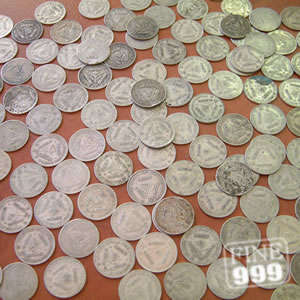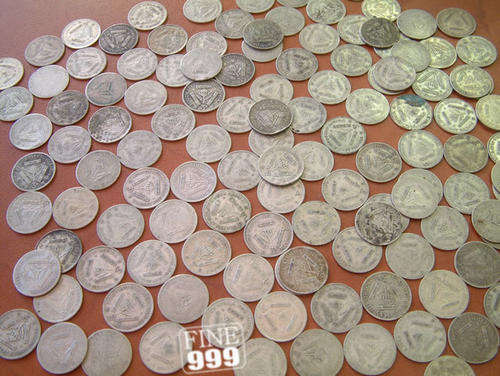
Silver Tickeys in 80% South African bullion coin - per gram
Check my rate
| Main centres: | 1-3 business days |
| Regional areas: | 3-4 business days |
| Remote areas: | 3-5 business days |

| Main centres: | 1-3 business days |
| Regional areas: | 3-4 business days |
| Remote areas: | 3-5 business days |
Each item is 1 gram by gross weight of 80% silver South African legal tender coin in Union of South Africa Tickeys. This is being sold as silver bullion by gross weight (i.e. the weight of the coin).
Select the number of grams you would like. I will make up a parcel of random coins. As this is bullion, conditions of the coins vary from excellent to having almost imperceptible images or with damage like bends, perforations etc. The photos provided give a good idea of the range of coins, quality, and distribution of different types (my stock photo).

In South Africa we used 50% silver coins as recently as 1964, and the 80% R1 coin up until 1969. Much of this silver coinage is still in existence and has the same appreciation potential as bullion based on the silver content.
Parcels contain (uncirculated gross weight):
3 pence (Tickey) 1.41g with approx 1.13g silver
Contains both King George V and VII coins.
Items can be combined from different auctions at highest shipping cost to save on postage. Add 2% of value of additional items to cover insurance.
Courier service is available. You may also arrange your own courier and insurance.
Parcels will be dispatched within 3 working days AFTER payment has been received.
If full payment is not made within 3 working days, a negative rating may be given.
Collections can be arranged in Port Elizabeth, waiving the postage.
Please visit our other listings:
http://www.bidorbuy.co.za/seller/1994136/fine999
FAQ
What are the advantages of legal tender silver coins vs pure silver bars and coin
Silver coins have the same appreciation potential as other forms. Silver coins are easily verifiable as silver and are illegal and difficult to forge. The numismatic value may also provide a floor to their value, and they may even appreciate in value as coins are converted to bullion and become rarer. Finally, in the event of a complete currently collapse, they may reappear as a means of exchange based on their silver content. The smaller denominations would then be more useful than larger silver pieces.
How can I test silver myself?
There are a number of tests you can do depending on the form and what's at hand:
Pass a magnet over the silver. It should not be attracted to the magnet.
File a small V in your silver. It should be shiny inside too, else it could be plated.
Flatten a small piece with a hammer. Silver is quite soft and malleable.
Use an Ohm-meter. Silver is highly conductive.
Silver melts at a lower temperature than Cupronickel.
Pure silver is very shiny (unless tarnished).
A silver test solution can differentiate between silver, gold and copper alloys. Contact us to put this on auction.
Feel and intuition. If you handle silver a lot, you will intuitively learn it's density, the sound it makes when dropped, and it's heat conductivity. Walk around with a silver coin in your pocket for a month.